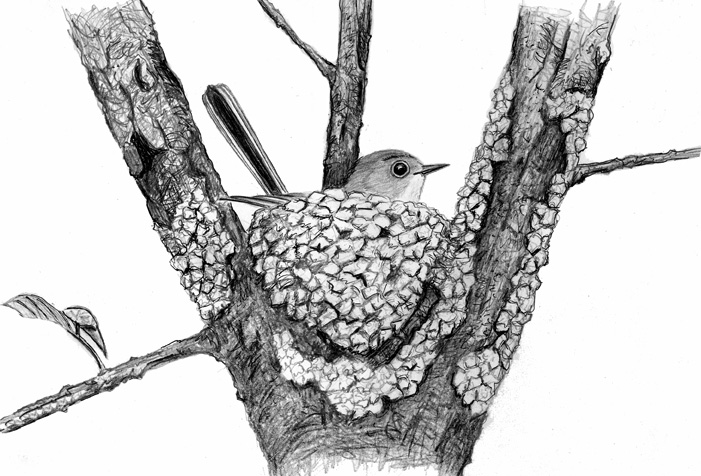
Dear Bird Folks,
While hiking yesterday I found this tiny nest lying on the ground. It appears to have been blown down in our most recent rainstorm. My husband thinks it looks like a hummingbird’s nest, but I’m not convinced. What do you think?
– Shawn, Truro, MA
I like your husband, Shawn,
While I don’t believe I’ve ever met him, he seems like a smart man. After all, he knows what a hummingbird’s nest looks like, plus he married you. Both of those things are good. There is only one problem. (Don’t worry, it has nothing to do with your marriage.) Even though the nest you found “looks like a hummingbird’s nest” (and it really does), it’s not. I know this for a fact because two years ago I found a nearly identical nest and it took me forever to get it identified. I’ll explain.
In early May of 2015 I was birding in Scusset Beach State Reservation, which is in Sandwich, or Bourne or Sagamore. (I’m not really certain which town it’s in, but I’m sure someone will correct me.) At Scusset I saw Ovenbirds, Blue-winged Warblers, Indigo Buntings and even an elusive Ruffed Grouse. As I was heading back to my car I came across a nest in the middle of the trail. Unsure what bird had made the nest I decided to take it back to Orleans with me. I mean, since being in possession of a bird’s nest is illegal, l I only brought back “photos” of the nest (wink, wink). For the next few days everyone at work tried to ID the nest. Like your husband, my entire staff suggested hummingbird, but I disagreed. The nest was tiny all right, but not nearly as tiny as a hummingbird’s nest. For weeks the nest builder remained a mystery, but it all changed when Alex arrived. Alex was a nineteen-year-old bird wizard we had hired for the summer. The minute Alex walked in the door we pulled out the nest (I mean, the photos) and asked him what he thought. After only a brief hesitation, Alex confidently announced, “That nest belongs to a Blue-grey Gnatcatcher.” It was that easy. (It’s always good to have a bird wizard on staff.)
Ever heard of a Blue-gray Gnatcatcher, Shawn? Probably not, but you should learn about them because they are headed our way. Since the beginning of the last century the population of some bird species has seen dramatic increases in Massachusetts. Birds that we now consider to be common (mockingbirds, cardinals, Carolina Wrens) are relatively new in these parts. Another one of these “new” birds is the Blue-gray Gnatcatcher. But unlike the other birds on the list, Blue-gray Gnatcatchers aren’t backyard birds and thus often go unnoticed by casual birders. And even if you are looking for them, the tiny gnatcatchers can be tough to find. How tiny are they? It would take two gnatcatchers to equal the weight of a chickadee, and we all know how obese chickadees are. The reasons for their population increase aren’t totally understood, but climate change and beavers are thought to be important factors. Why beavers? For nearly 200 years beavers were absent in Massachusetts. But as the silly habit of wearing animal fur waned, the beavers have returned and along with them came birds that are attracted to the moist habitat the beavers create, including the tiny gnatcatchers. Yay!
As their name suggests, Blue-gray Gnatcatchers are mostly colored blue-gray. They also have white bellies and long black tails that are edged in white, which they constantly flash in an apparent effort to flush prey (i.e. gnats, and other gnat-like things). By most standards, gnatcatchers are fairly plain looking birds with all the colorful pizzazz of a Tufted Titmouse. But that doesn’t mean these birds are boring. Gnatcatchers are in constant motion, relentlessly searching tree branches for food. Another clue to a gnatcatcher’s presence is its incessant high-pitched buzzy call. However, I’ll have to take its word for it. High calls have long moved beyond my hearing range. (Lately, I’ve been looking for birds that use closed captioning.)
What Blue-gray Gnatcatchers lack in color, or in my case, sound, they make up for with their creative nest building skills. The nests of many of our songbirds are basically brown, and why not? Brown is a natural camouflage. But gnatcatchers take the camo thing to another level. Instead of using brown material (dried grass, twigs, pine needles, etc.), gnatcatchers use plant fibers and bark strips, and bind them all together with spider web silk. Then, in order to add a cloak of invisibility, they “shingle” the outside with tiny bits of lichen. From a distance, the nest now looks like a knot in the tree. On a walk last week I stumbled upon a pair of gnatcatchers that were in the process of nest building. Through my binoculars I could clearly see the birds at work, but the minute I lowered my binos, I couldn’t find the nest. I had to wait for one of the birds to fly in with a fresh bit of lichen before I could locate it again. I realize that’s not the most exciting story I’ve ever told, but that’s about as exciting as a story about gnats and lichen can get.
I hope you see a gnatcatcher someday, Shawn. Keep looking for a blur of activity around the outer edges of tree branches, or listen for a constant high-pitched buzzy sound. That could be the song of a Blue-gray Gnatcatcher; although, in my case, it’s most likely tinnitus.